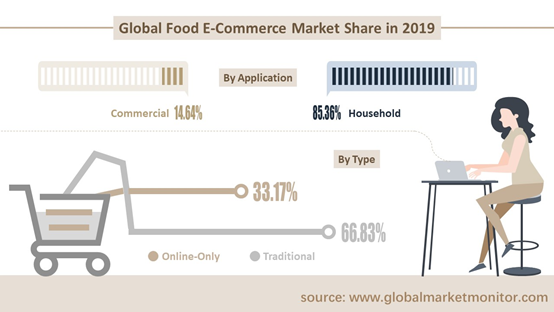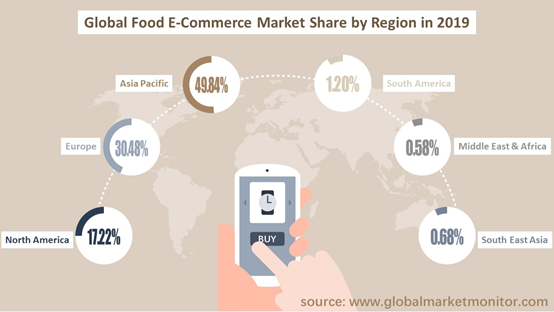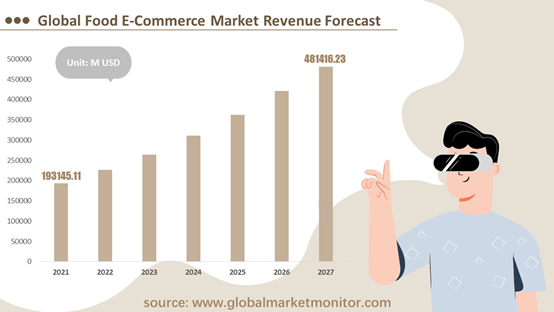E-commerce is short for electronic commerce, which refers to trading activities and related service activities conducted electronically on the Internet, intranets and value-added networks, as well as the electronic and networked aspects of traditional business activities. Food e-commerce, on the other hand, is a market where retailers or brand owners sell food products directly to customers via the Internet. It has huge and obvious advantages over traditional business models for it breaks through the limitations of time and space, expands the consumer base and reduces costs.
Currently, there are two main types of food e-commerce: traditional and online-only. Traditional channels include traditional hypermarkets, supermarkets, convenience store chains and individual grocery stores. These channels combine online and offline to reconfigure people, goods and markets to create a new shopping experience. The online-only channel refers to online transactions that dramatically save shopping time and eliminate shopping fatigue. Second, online stores simplify the intermediate link from manufacturer to retailer, saving miscellaneous expenses such as rent, labor costs, industrial and commercial utilities, and inventory fees that need to be paid by physical sales sites. In 2019, the market shares of these two channels accounted for 66.83% and 33.17%, respectively, which are closely related to consumption habits of consumers. The streets of the city are filled with dense supermarkets and convenience stores, where consumers buy casual foods not only conveniently, saving the waiting time of online shopping, but also more securely.

The downstream applications of food e-commerce are divided into household and commercial, with a market share of 85.36% and 14.64% in 2019, respectively. With the change in lifestyle and consumption patterns of residents in various countries, food e-commerce has a promising future and the market size is expanding day by day.
Prospect Analysis of the Food E-commerce Industry in Various Regions
The food e-commerce industry is in its growth phase, which open and global nature creates more trading opportunities for companies. In recent years, more and more companies are participating in the industry and competition is getting fierce. Top three companies in 2019 are Amazon, Tesco and Walmart, with market shares of 7.56%, 3.75% and 2.36%.
As the basic guarantee of personal life, food industry has been developing well. In the international market now, the development of e-commerce around the world has become more and more mature. 2019, North America, Europe, Asia Pacific, South America, Middle East & Africa and Southeast Asia accounted for 17.22%, 30.48%, 49.84%, 1.20%, 0.58% and 0.68% of the market share, respectively.
Get the Complete Sample, Please Click: https://www.globalmarketmonitor.com/reports/762416-food-e-commerce-market-report.html

China and India, both populous countries, are located in Asia Pacific, providing a large consumer base for the food e-commerce industry, making the place the largest revenue market worldwide. The market share in Asia Pacific was 45.69% in 2015, increasing to 50.84% in 2020, an increase of 5.15%. Food industry of China is the top industry in its modern industrial system and the number one food industry in the world. The country\'s expansion of domestic demand has provided the driving force for the development of the food industry. At the same time, the rising income level of urban and rural residents has led to an increasing demand for food and higher requirements. It is expected that the food e-commerce industry will continue to grow steadily in the future, with a steady expansion of the industry scale, which has an important role in promoting Asia-Pacific and even the global market.
In the information age, precise marketing has become the development direction of food industry transformation. Food e-commerce is in line with the modern fast-paced lifestyle because people can shop for what they want anytime and anywhere. With the development of the Internet, the U.S. e-commerce platform is increasingly mature, thus cross-border e-commerce brings new opportunities for enterprises. Relying on the advantages of capital, technology and talent, U.S. food e-commerce is growing strongly and it will drive North America to be the fastest growing region.
The Epidemic Has Led to the Development of Food E-commerce, Companies Should Combine Online and Offline to Avoid the Monolithic Sales Channels
COVID-19 epidemic of 2020 has brought a shock to retail commerce, but it has also triggered a change in consumer shopping habits. Online food shopping has now become an important channel for people.
The key drivers of the future growth are influenced by user size and technological developments. The Internet is becoming increasingly popular, so online shopping users are growing exponentially, and the scale of food e-commerce consumers is expanding. Secondly, people\'s purchasing habits and consumption concepts have changed, so live-streaming with goods has brought greater room for development for food e-commerce. In addition, with the progress of preservation technology, food e-commerce will break through the previous biggest obstacle - the preservation problem, and then soar.

The study shows that the food e-commerce size increased year-on-year from 2015-2020, from $72,819.08 million to $168,124.96 million. We forecast the global food e-commerce industry market value will reach $481,416.23 million in 2027, equivalent to three times the size in 2020.
Although compared with the traditional offline channels, food e-commerce channels have price advantages, easier to break through the space restrictions, to achieve accurate service. But at the same time, the drawbacks of online consumption gradually embodied. Food e-commerce sales with a lack of sex, touchability, perceptibility and other disadvantages, which has also become a casual snacks online sales of a major (hard). In the future, under the continuous penetration of the Internet and e-commerce, the combination of online and offline, and omnichannel development will become the future development trend of food e-commerce.
Get the Complete Sample, Please Click: https://www.globalmarketmonitor.com/reports/762416-food-e-commerce-market-report.html
We provide more professional and intelligent market reports to complement your business decisions.